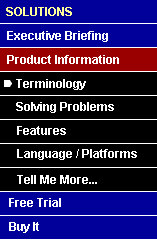
Terminology (What stuff means.)
Text Retrieval is becoming widely known thanks to the Internet, but it's origins can be traced back to mainframes in the mid to late 1960's. Power, performance and features have changed a lot since then - but not the objective;
Make it easier for people to find information in a computer.
Typically, text-retrieval engines (or search engines as many people call them today) create and use full-text indexes for efficiency when translating a user's "query" into a set of matching documents or records. Conceptually, a query is a pattern or set of values that is to be tested against all the documents or records in a "collection" (some defined group of those documents or records) to find those that match what the user is looking for.
Capabilities and focus of various tools vary in significant respects in terms of how they;
- Create and maintain the indexes
- Determine what query command string to build
- Link queries to business activities
By first determining where your applications (internal or customer/partner facing) could benefit from improved data access, you will be better able to choose the tool(s) for the job.
- BOOLEAN Search
- An expression of words or patterns connected by AND, OR and NOT that delivers results that satisfy the conditions expressed. The statements "this OR that", "this AND that" as well as "this AND NOT that" are examples of Boolean expressions. (Psychic Psearch implements this type of functionality in a user friendly way.)
- FUZZY Search
- Just like you might expect, this search is not exact. A fuzzy search will try to return answers that are close to what you have asked for based on spelling or topic. Sometimes you wonder what the definition of "close" is when you see some of the results. (Psychic Psearch doesn't use this. Too, well... fuzzy.)
- PRECISION Searching
- A technical term referring to the percentage of results returned that actually contain what the user was looking for. (Psychic Psearch provides a high degree of precision and a very low occurrence of "false hits".)
- Taxonomy
- Information structuring techniques including links, hierarchies and tables that make relationships explicit. Some are so large that they need their own full-text index so the user can find the right place to go. Because they are typically defined and maintained manually, they are subject to all the associated issues of manual methods. Items can get lost by being spelled incorrectly, or by apparently illogical placement in the structure. (Would you look for a cellular phone under "Radio Frequency Hardware" ?)
See a term used on this Web Site you are not familiar with?
Send a message to
webmaster@resultsfirst.com
Home | Contact | Legal & Privacy | Site Map | Buy It